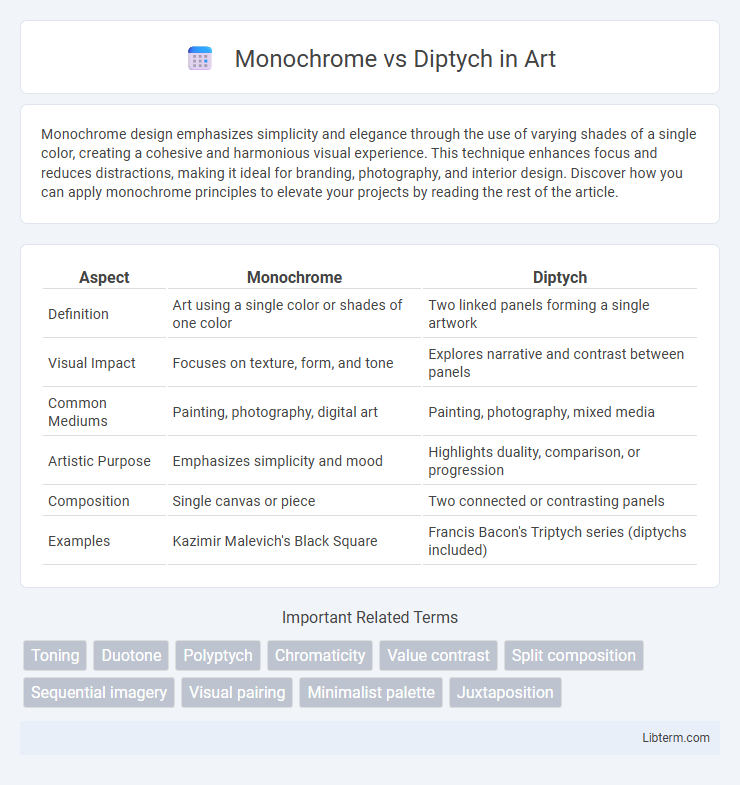Monochrome design emphasizes simplicity and elegance through the use of varying shades of a single color, creating a cohesive and harmonious visual experience. This technique enhances focus and reduces distractions, making it ideal for branding, photography, and interior design. Discover how you can apply monochrome principles to elevate your projects by reading the rest of the article.
Table of Comparison
| Aspect | Monochrome | Diptych |
|---|---|---|
| Definition | Art using a single color or shades of one color | Two linked panels forming a single artwork |
| Visual Impact | Focuses on texture, form, and tone | Explores narrative and contrast between panels |
| Common Mediums | Painting, photography, digital art | Painting, photography, mixed media |
| Artistic Purpose | Emphasizes simplicity and mood | Highlights duality, comparison, or progression |
| Composition | Single canvas or piece | Two connected or contrasting panels |
| Examples | Kazimir Malevich's Black Square | Francis Bacon's Triptych series (diptychs included) |
Understanding Monochrome Photography
Monochrome photography emphasizes shades of a single color, often black and white, to highlight texture, contrast, and composition without the distraction of multiple hues. This technique enhances emotional depth and timelessness, making fine details more prominent and creating a strong visual narrative. Understanding light, shadow, and tone variations is crucial for mastering the artistic expression inherent in monochrome images.
Exploring the Diptych Format
The diptych format, characterized by two connected panels, offers a dynamic way to explore contrasting themes or complementary narratives within a single artwork. Unlike monochrome pieces that emphasize a single color or tone, diptychs allow artists to juxtapose different visual elements, creating a dialogue that enhances depth and meaning. This format is especially effective in storytelling and thematic exploration, providing viewers with a multifaceted experience through paired compositions.
Key Differences: Monochrome vs Diptych
Monochrome refers to artwork or photography created using variations of a single color, emphasizing tone, texture, and contrast to evoke emotion and mood. A diptych consists of two related panels or images displayed side by side, often contrasting or complementing each other to convey a narrative or thematic connection. The key difference lies in monochrome's focus on a unified color scheme within a single composition, while diptychs explore duality and dialogue between two distinct yet connected works.
Visual Storytelling in Monochrome
Monochrome images enhance visual storytelling by emphasizing shapes, textures, and contrasts without the distraction of color, allowing viewers to engage deeply with the subject's emotions and atmosphere. The use of light and shadow in monochrome photography creates a powerful mood, guiding the audience's focus toward the narrative's core elements. In comparison to diptychs, which present two related images side by side to convey a sequence or contrast, monochrome relies on tonal variation to evoke a singular, immersive story.
Narrative Power of Diptychs
Diptychs harness the narrative power of juxtaposition by presenting two complementary images that create a dialogue, enriching storytelling beyond the limits of a single monochrome image. This format enables artists to explore themes such as contrast, progression, and duality, deepening emotional resonance and conceptual complexity. The interplay between the paired panels in diptychs enhances viewer engagement through visual tension and thematic interplay, making them a potent tool for conveying multifaceted narratives.
Creative Techniques for Each Style
Monochrome photography emphasizes tonal contrasts, textures, and lighting to create depth and mood, often utilizing high contrast or subtle gradients to evoke emotion. Diptych compositions explore narrative and visual relationships by juxtaposing two images, encouraging viewers to find connections or contrasts between subjects, themes, or perspectives. Techniques involve careful selection of complementary or opposing elements, alignment, and balance, enhancing storytelling through paired imagery.
When to Choose Monochrome Photography
Monochrome photography excels in situations where emphasizing texture, contrast, and emotion is crucial, such as portraiture or architectural shots that benefit from timeless simplicity. Choosing monochrome is ideal when the removal of color distractions helps highlight composition elements and enhances mood through light and shadow interplay. This approach is particularly effective in low-light or high-contrast environments where color may detract from the image's core message.
Best Subjects for Diptychs
Diptychs excel with subjects that contrast or complement each other, such as nature scenes paired with architectural images, or portraits alongside abstract textures. The dual-panel format enhances storytelling by juxtaposing different perspectives, emotions, or moments within a cohesive theme. Ideal subjects include before-and-after sequences, day and night settings, or thematic pairs like urban life versus rural landscapes.
Combining Monochrome with Diptych Presentations
Combining monochrome imagery with diptych presentations enhances visual storytelling by emphasizing contrast and harmony within a two-panel format. Monochrome's focus on tonal variation and texture complements the diptych's ability to juxtapose related themes or moments, creating a powerful narrative flow. This fusion leverages simplicity and duality, inviting deeper viewer engagement through minimalistic yet compelling composition.
Monochrome vs Diptych: Final Thoughts and Recommendations
Monochrome images evoke strong emotional responses through simplicity and tonal variation, making them ideal for minimalist and dramatic compositions. Diptychs create dynamic visual narratives by juxtaposing two complementary or contrasting images, perfect for storytelling and exploration of themes. Choosing between monochrome and diptych depends on the desired impact: monochrome for focused mood enhancement, diptych for layered meaning and visual dialogue.
Monochrome Infographic

 libterm.com
libterm.com